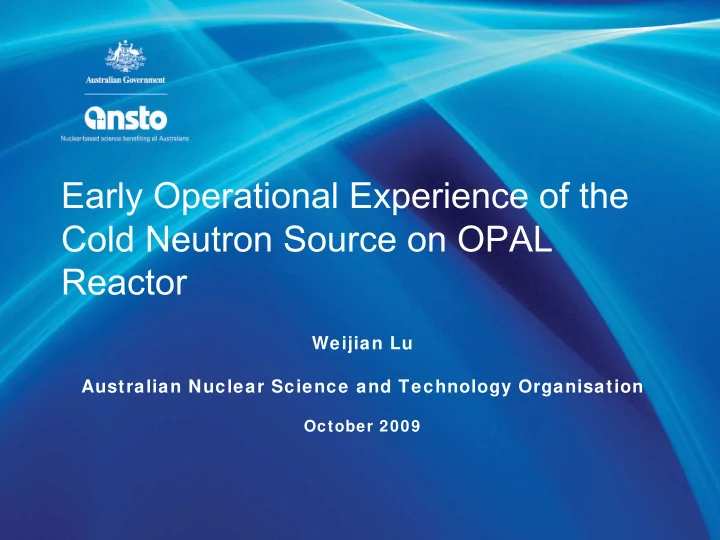

Early Operational Experience of the Cold Neutron Source on OPAL Reactor Weijian Lu Australian Nuclear Science and Technology Organisation October 2009
The OPAL Reactor • 20 MW multi-purpose research reactor • Compact core (MTR-type fuel) • Light water cooled and moderated • Heavy water reflected • Radiopharmaceutical Production • Neutron Beam Research
CORE PCS PIPE The OPAL Reactor CRYO-PIPE CNS
Important Contract Requirements Fulfilled • 20 litres of single phase liquid deuterium at below 25 K • Cryogenic power specification – 5 kW • A standby mode – reactor operating at full power without cryogenic cooling • Cold neutron flux at reactor face (~low 10 10 n · cm -2 · s -1 ) and through neutron guides (~mid 10 9 n · cm -2 · s -1 )
An International Project • INVAP, Argentina – overall design, project management, CNS process systems • PNPI, Russia – In-pile (vacuum containment and thermosiphon), deuterium gas • Air Liquide, France – helium cryogenic system • Mirrortron, Hungary – neutron guides
Mechanical Design CNS Vacuum Containment Support Tube Beam Tube Reactor Face
Thermosiphon Model LD 2 He inlet HX flow He inlet MC flow He outlet flow
Thermosiphon Deuterium Pipe Bayonet Connectors Helium tube Heavy Water Flange Outlet Pipe Heat Exchanger Heavy Water Inlet Pipe Neutron Reflector Moderator Chamber
Moderator Chamber with Displacer (AlMg5)
MCNP 3-D Model
Timeline CNS Thermosiphon prototype tests CNS-RCS factory acceptance tests On-site CNS-RCS tests with bypass On-site CNS-VS, CNS-MS, CNS-GBS tests CNS-RCS integration with in-pile assembly (cryogenic) OPAL Cold Commissioning commences CNS Liquefaction of deuterium OPAL criticality and then 20 MW CNS Hot Commissioning CNS Routine operation Jan 03 Jan 04 Jan 05 Jan 06 Jan 07 Jan 08
Heat Load Measurement • Heat load measured by steady state helium thermal balance => 4 kW • Excellent agreement between measurement and theoretical prediction ( Δ <100 W) • Single phase moderator verified • (See conference proceeding for details)
Heat Load vs Reactor Power Measured Heat Load on the CNS In-pile by Cryogenic Helium Thermal Balance Linear fits indicate nuclear heat load (W/MW) by the slope and non-nuclear heat load by the offset (W) 3500.00 Liquid Deuterium y = 1 80.49x + 387.57 3000.00 R 2 = 0.9999 Gas Deuterium 2500.00 Linear (Gas Deuterium) 2000.00 Linear (Liquid Deuterium) 1500.00 1000.00 y = 85.666x + 363.1 R 2 = 0.9988 500.00 0.00 0 2 4 6 8 10 12 14 16 18 20 Reactor Power (M W)
Single-Phase Verified LD2 Heat Load 95.00 1.105 93.00 1.085 Normalisation to Saturation 91.00 Saturation Point 1.065 89.00 1.045 87.00 1.025 1.005 85.00 0.985 83.00 0.965 81.00 0.945 79.00 0.925 77.00 0.905 75.00 0.885 25 25.5 26 26.5 27 27.5 28 28.5 29 29.5 30 30.5 31 He Outlet Temp. (K)
Flux Contract Performance Performance Acceptance Criteria OPAL measured flux (20 MW equiv) (RF = reactor face) ( in n/cm 2 /sec) (NGH = neutron guide hall) Thermal neutron flux at RF for TG4 [1] 4.0 x 10 10 Thermal neutron flux in NGH for TG1(TG3) [1] 3.3 (2.8) x 10 9 Cold neutron flux at RF for CG4 [2] 2.5 x 10 10 Cold neutron flux in NGH for CG1(CG3) [2] 5.9 (6.4) x 10 9 [1] E < 100 meV [2] E < 10 meV
Operation Issues (positive) • Standby Operation (SO) mode and Normal Operation (NO) mode at full reactor power • Two way transition • SO mode greatly enhances reactor availability – hot commissioning on time made possible • CNS safety control – 30-minute fast LD2 evaporation manoeuvre after CNS trip to beat xenon poison-out
Operation Issues (negative) • Repeated cryogenic system failures affecting CNS availability Turbine and compressors Mechanically demanding Sensitive to process purity • Complex logic in the protection system Preventing undesirable pressure and temperature transients CNS specialist intervention often required
Recommend
More recommend